Field work in Antarctica
You can follow our scientists on expeditions (2010/11 and 2011/12) into Antarctica and get insights into their exciting work via the IMCOAST Science Blog.
Here are some reports from the field season 2009/10:
Patrick Monien and Sanja Asendorf from ICBM, Oldenburg University are invesitigating in AP-7 the geochemical response of sedimentary archives to glacier retreat. They report the following from their field work 2009/2010:
Along several transects the main meltwater streams draining into Potter Cove, King George Island, were sampled monthly in order to characterize the particulate (SPM) and dissolved load of glacial effluents draining into the cove at different times by inorganic geochemical methods (major and minor elements, nutrients).
To investigate the extent of meltwater drainage and SPM input 30 surface sediment cores (< 30 cm) were taken on a 400 m grid by gravity and push corer. Based on provenance analyses we will document whether the material introduced into this bay is evenly distributed and uniform in composition or if specific source areas can be distinguished by their chemical signature. For this purpose also soils and rocks from different sites at Potter Peninsula were sampled to get more information about the geochemistry of the supply area and its current state of chemical weathering. Additionally, it will be studied whether the reported increase in SPM may be quantified by determining sediment accumulation rates with 210Pb.
Furthermore, five longer sediment cores (30-50 cm) were taken from the deposition centres in the middle of the inner cove and near the glacier that may serve as archives for the climatic and paleoenvironmental development of this area during the last century. Inorganic geochemical proxies may document the gradual glacier retreat in Potter Cove and may be possibly applied on new and already existing core material from Maxwell Bay and on lake cores from the Fildes Peninsula.
The results of this study will contribute to assess whether the documented temperature increase and associated glacier retreat at WAP is reflected in the sedimentary record and weather such episodes have occurred within the Holocene before.
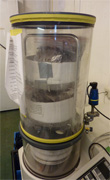 |
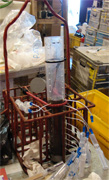 |
 |
 |
Luciana Torre is doing her PhD on ""Energy and Matter flows between the pelagic and benthic systems at Potter Cove (Antarctica): Consecuences on the benthic community structure and prediction of the possible effects of global change" , under supervision of Dr. Fernando Momo at the National University of General Sarmiento (UNGS), Argentina. She reports:
My work is an experimental and mathematical approach about how Global Warming phenomena could be affecting Antarctic marine communities. In the frame of this investigation I have participated in three Antarctic Expeditions during the austral summers in 2006/2007, 2007/2008 and 2009/2010. I have been studying population dynamics of the most representative benthic species. In these expeditions I have carried out samplings and experiments to determinate the physiological response of this species to environmental change (in particular to particulate matter increasement). I have worked in cooperation with Dr. Abele from Alfred Wegener Institute in the physiological studies. I have also collaborated with Dr. João Frederico Meyer at the Department of IMECC at the University of Campinas (UNICAMP), Brazil, to develop spatial models of community dynamics. My principal interest now is to include all this physiological parameters into models to simulate the effect of these environmental changes at population and community level.
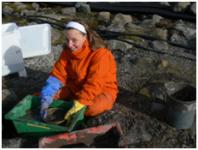 |
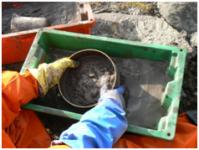 |
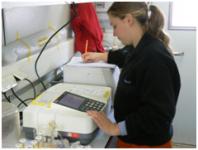 |
Dolores Deregibus is doing her PhD on “ Depth Distribution of Antarctic Macroalgae Under a Global Change Scenario“ under the supervision of María Liliana Quartino (IAA, Argentina), Katharina Zacher and Christian Wiencke (both AWI, Germany):
Climate warming has especially been related to glacial retreat along the Western Antarctic Peninsula. One example of this situation is observed at Potter Cove (Jubany Station, Isla 25 de Mayo/King George Island) where over the last years visible melting of Glacier Fourcade has exposed new ice-free areas which have become available for benthic colonization, but also an alteration of the water column (due to an increase of sediment input and salinity changes) and on the ice disturbance patterns are occurring in coastal areas.
My project focuses on the change of the environmental conditions and the expected shift of the lower distribution limit of macroalgae and their communities from deep to shallower waters in these new ice-free areas. I have participated in the field campaign 2009/2010 and will participate in the next field campaign 2010/2011 at Jubany Station analysing and comparing (1) the macroalgal zonation from a physiological point of view and (2) long-term colonization experiments, in five new ice-free areas with a different degree of glacial influence. The results of this study will help to understand changes in macroalgal zonation and composition and if they could have subsequent cascading effects through the food webs and thus, community structures in this shallow water ecosystems of Potter Cove.
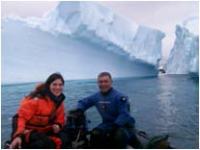 |
 |
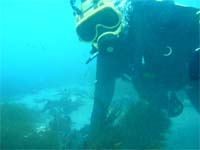 |
Katharina Zacher (AWI, Germany), Gabriela Campana and Dolores Deregibus (both IAA, Argentina), invesitigate jointly the impact on climate change on benthic micro- and macroalgae. They report:
An increase in UV radiation and temperature is observed over the last decades in Antarctica. Therefore the estimation of consequences due to the changing environment on the Antarctic ecosystem is important. Although proven to be of great importance to the shallow water ecosystem, Antarctic benthic algae have rarely been studied.
The focus of our study lies on ecological studies of macro- and microalgal communities, and physiological experiments of macroalgae and their young developmental stages (as they are shown to be most susceptible to anthropogenic stresses). The planned field-experiments with spores and germlings are the first attempts to detect differences in germination due to UV radiation in the Antarctic region. Macroalgal spores of different species were exposed in field experiments in the water column under different light conditions (1. including the complete light spectrum, 2. minus UV-A radiation, 3. minus UV radiation) and postcultered in the laboratory. Germination rates were estimated after 3 or 6 days, respectively.
Furthermore experiments on the impact on salinity and temperature changes on the photosynthetic performance of macroalgal spores were conducted. The results of the experiments planned will help to understand more about the dynamics of the Antarctic ecosystem under a changing environment.
 |
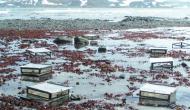 |
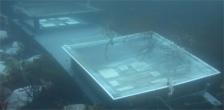 |

